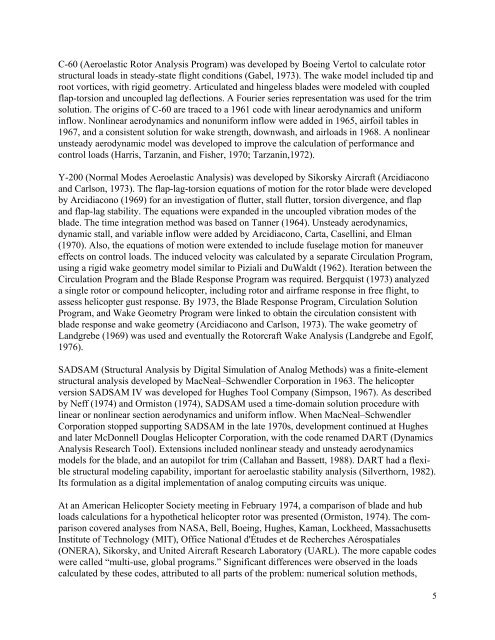A History of Rotorcraft Comprehensive Analyses
A History of Rotorcraft Comprehensive Analyses
A History of Rotorcraft Comprehensive Analyses
You also want an ePaper? Increase the reach of your titles
YUMPU automatically turns print PDFs into web optimized ePapers that Google loves.
C-60 (Aeroelastic Rotor Analysis Program) was developed by Boeing Vertol to calculate rotor<br />
structural loads in steady-state flight conditions (Gabel, 1973). The wake model included tip and<br />
root vortices, with rigid geometry. Articulated and hingeless blades were modeled with coupled<br />
flap-torsion and uncoupled lag deflections. A Fourier series representation was used for the trim<br />
solution. The origins <strong>of</strong> C-60 are traced to a 1961 code with linear aerodynamics and uniform<br />
inflow. Nonlinear aerodynamics and nonuniform inflow were added in 1965, airfoil tables in<br />
1967, and a consistent solution for wake strength, downwash, and airloads in 1968. A nonlinear<br />
unsteady aerodynamic model was developed to improve the calculation <strong>of</strong> performance and<br />
control loads (Harris, Tarzanin, and Fisher, 1970; Tarzanin,1972).<br />
Y-200 (Normal Modes Aeroelastic Analysis) was developed by Sikorsky Aircraft (Arcidiacono<br />
and Carlson, 1973). The flap-lag-torsion equations <strong>of</strong> motion for the rotor blade were developed<br />
by Arcidiacono (1969) for an investigation <strong>of</strong> flutter, stall flutter, torsion divergence, and flap<br />
and flap-lag stability. The equations were expanded in the uncoupled vibration modes <strong>of</strong> the<br />
blade. The time integration method was based on Tanner (1964). Unsteady aerodynamics,<br />
dynamic stall, and variable inflow were added by Arcidiacono, Carta, Casellini, and Elman<br />
(1970). Also, the equations <strong>of</strong> motion were extended to include fuselage motion for maneuver<br />
effects on control loads. The induced velocity was calculated by a separate Circulation Program,<br />
using a rigid wake geometry model similar to Piziali and DuWaldt (1962). Iteration between the<br />
Circulation Program and the Blade Response Program was required. Bergquist (1973) analyzed<br />
a single rotor or compound helicopter, including rotor and airframe response in free flight, to<br />
assess helicopter gust response. By 1973, the Blade Response Program, Circulation Solution<br />
Program, and Wake Geometry Program were linked to obtain the circulation consistent with<br />
blade response and wake geometry (Arcidiacono and Carlson, 1973). The wake geometry <strong>of</strong><br />
Landgrebe (1969) was used and eventually the <strong>Rotorcraft</strong> Wake Analysis (Landgrebe and Egolf,<br />
1976).<br />
SADSAM (Structural Analysis by Digital Simulation <strong>of</strong> Analog Methods) was a finite-element<br />
structural analysis developed by MacNeal Schwendler Corporation in 1963. The helicopter<br />
version SADSAM IV was developed for Hughes Tool Company (Simpson, 1967). As described<br />
by Neff (1974) and Ormiston (1974), SADSAM used a time-domain solution procedure with<br />
linear or nonlinear section aerodynamics and uniform inflow. When MacNeal Schwendler<br />
Corporation stopped supporting SADSAM in the late 1970s, development continued at Hughes<br />
and later McDonnell Douglas Helicopter Corporation, with the code renamed DART (Dynamics<br />
Analysis Research Tool). Extensions included nonlinear steady and unsteady aerodynamics<br />
models for the blade, and an autopilot for trim (Callahan and Bassett, 1988). DART had a flexible<br />
structural modeling capability, important for aeroelastic stability analysis (Silverthorn, 1982).<br />
Its formulation as a digital implementation <strong>of</strong> analog computing circuits was unique.<br />
At an American Helicopter Society meeting in February 1974, a comparison <strong>of</strong> blade and hub<br />
loads calculations for a hypothetical helicopter rotor was presented (Ormiston, 1974). The comparison<br />
covered analyses from NASA, Bell, Boeing, Hughes, Kaman, Lockheed, Massachusetts<br />
Institute <strong>of</strong> Technology (MIT), Office National d'Études et de Recherches Aérospatiales<br />
(ONERA), Sikorsky, and United Aircraft Research Laboratory (UARL). The more capable codes<br />
were called multi-use, global programs. Significant differences were observed in the loads<br />
calculated by these codes, attributed to all parts <strong>of</strong> the problem: numerical solution methods,<br />
5
















